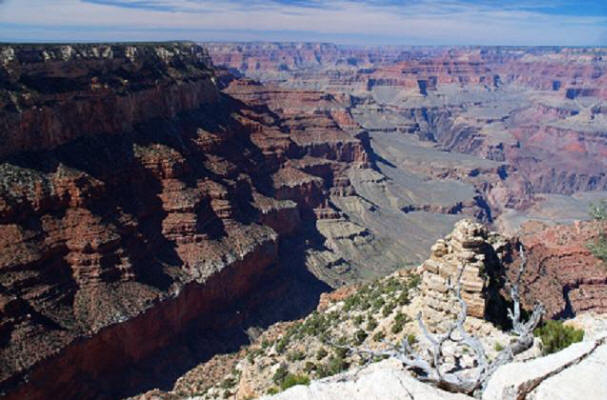
home •
about •
essential guide •
picture of the day •
thunderblogs •
news •
multimedia •
predictions •
products •
get involved •
contact
picture of the day archive subject index
View of Yaki Point with periodic cliff formations.
Oct 01, 2008
The Grand Canyon: Part Two
Simple observation of the Grand Canyon's geological formations calls the water erosion hypothesis into question.A few variables in an electric discharge can produce a wide variety of shapes and patterns. The polarity makes a difference, so cathode discharges create different patterns than those from an anode.
When we speak of charged planets imbedded in the sun's plasmasphere, they may be positively charged or negatively charged—the important factor is whether they touch one another. When the teardrop shaped double layers, or Langmuir sheaths, surrounding planets come close enough a discharge connection is made. The nature and strength of an interplanetary discharge might depend on a number of factors: charge accumulation, potential, conductivity of the surface strata, and current flow.
If electric current discharges stick to a surface they tend to rotate around a point and leave a circular crater with a raised center area. If the discharge is narrow and intense like a lightning bolt, it will leave a deep, sharp cut in the substrate and the material will be accelerated away from the point of contact.
Where the electric arc contacts and runs along or under the surface, Birkeland currents might create a rille, or canyon-shaped excavation. Often, this type of discharge forms a series of overlapping craters, imparting a sculpted effect to the canyon wall with periodic notches in the rim. Finally, the discharge energy dissipates and forms a kind of "wash" that is generally lower in elevation than the initial touchdown point.
In any heavy discharge the surrounding terrain swells and becomes uplifted. In that case, the result is a "blister" or raised area called a fulgamite. The size and shape of the fulgamite depends on the underlying material properties as mentioned above.
The Grand Canyon's tributaries are generally short with little evidence of the necessary water flowing into the ends from the high desert floor. The jagged tributaries are deeply cut and are characterized by nearly vertical walls. They join the main canyon at right angles, a distinctive sign of electric discharge phenomena.
Another unusual aspect to the Grand Canyon is the "islands" that rise up from broad bases to the rim level. They are delicate in comparison to the size of the canyon. They are close to the canyon walls and demonstrate parallel stratigraphy. How the water flow remained diverted around these islands, or how erosion over millions of years could have created them without undercutting and subsequent collapse is difficult to explain.
In conclusion, the lack of eroded debris cannot be passed over lightly. Not only is a vast amount of material from the Grand Canyon missing, but a much greater amount of material is missing from the same general area. Zion, Bryce Canyon, Monument Valley, Canyonlands, and the Colorado Plateau have been extensively eroded. Rock and soil has been removed to a depth of more than a kilometer.
The top strata of the Grand Canyon makes up the bottom strata of Zion, and the top of Zion continues to the bottom of Bryce Canyon. The region of missing material is known as the Great Denudation. Together with the Grand Canyon the volume of missing debris amounts to tens of thousands of cubic kilometers. How can this be?
Contributed by Michael Armstrong
___________________________________________________________________________Please visit our Forum
The Electric Sky and The Electric Universe available now!

|
|

|
EXECUTIVE EDITORS:
David Talbott, Wallace Thornhill
MANAGING EDITORS:
Steve Smith, Mel Acheson
CONTRIBUTING EDITORS: Michael Armstrong, Dwardu Cardona,
Ev Cochrane,
C.J. Ransom, Don Scott, Rens van der Sluijs, Ian Tresman
WEBMASTER: Brian Talbott
Copyright 2007: thunderbolts.info
![]()
home •
thunderblogs •
forum •
picture of the day •
resources •
team •
updates •
contact us

